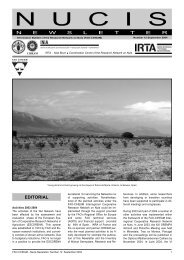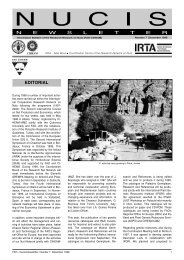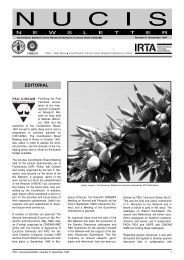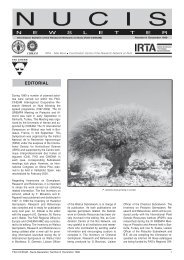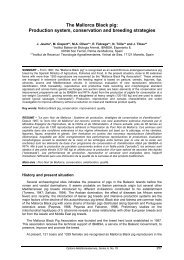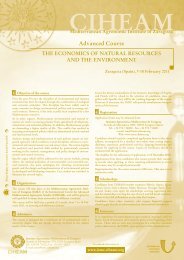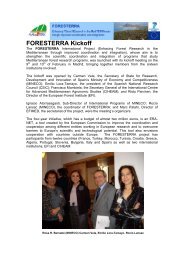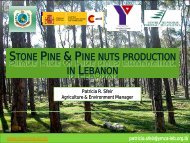NUCIS number 10. December 2001. 48 pages (full ... - IAMZ - ciheam
NUCIS number 10. December 2001. 48 pages (full ... - IAMZ - ciheam
NUCIS number 10. December 2001. 48 pages (full ... - IAMZ - ciheam
Create successful ePaper yourself
Turn your PDF publications into a flip-book with our unique Google optimized e-Paper software.
72° 68°<br />
CHILE<br />
Table 2. Total yield and superior nuts from trees of selected Gevuina VAX clones<br />
VAX Clones Total yield (kg/tree) Nut >2.5 g (kg/tree)<br />
53 24.63 14.53<br />
33-42-43-64 24.66 5.98<br />
21 8.07 5.97<br />
19°<br />
Iquique<br />
I REGIÓN<br />
19°<br />
Antofagasta<br />
II REGIÓN<br />
Table 3. Yield per hectare at peak production of six Gevuina VAX<br />
clones with two plant arrangements<br />
Copiapó<br />
III REGIÓN<br />
Clones NIS avg. (kg/ha) Kernel avg. (kg/ha)<br />
43-53-64<br />
(4.0 x 6.0 m = 416 trees/ha) 11,<strong>48</strong>5 4,247<br />
LaSerena<br />
IV REGIÓN<br />
32°<br />
Valparaiso<br />
V REGIÓN<br />
Rancagua<br />
VI REGIÓN<br />
Santiago<br />
REGIÓN METROPOLOTANA<br />
32°<br />
21-33-42<br />
(3.0 x 5.0 m= 666 trees/ha) 10,773 4,235<br />
Talca<br />
VII REGIÓN<br />
Concepción<br />
VIII REGIÓN<br />
Temuco<br />
IX REGIÓN<br />
Puerto Montt<br />
X REGIÓN<br />
43°<br />
Coyhaique<br />
XI REGIÓN<br />
Punta Arenas<br />
XII REGIÓN<br />
90° 53°<br />
43°<br />
TERRITORIO CHILENO ANTÁRTICO<br />
SELECTED CLONES FOR NUT<br />
PRODUCTION<br />
The selected six clones are part of 119<br />
accessions evaluated among the years<br />
1977 and 2000 (Fig. 3). They are grouped<br />
by their rusticity in the series VAX that<br />
adapt in productivity to temperate climate<br />
(frost resistance), with a lack of summer<br />
rainfall (hydric stress) and soils of low natural<br />
fertility and good drainage (Medel,<br />
1988; Medel, 2001 b). The clones began<br />
their production between the 3rd and 5th<br />
year of age, arriving to their productive<br />
peak between the 8th and 10th year, to<br />
continue with a stabilized production.<br />
shell. The kernel is cream-white with a<br />
crisp texture, rich flavor and good taste<br />
(Figs. 4, 5 and 6).<br />
A synthesis of the central characteristics<br />
of the six clones are presented at Table<br />
1, qualifying them mainly by their yield,<br />
nut characteristics (NIS: nut-in-shell, kernel,<br />
shell) and vigor of the trees. In Table<br />
2 the total yield and the kg/tree of high<br />
class of nuts (>2.5 g) are exposed, that<br />
show an important proportion of kernels<br />
with a weight superior to 1.0 g, and therefore<br />
their commercial value for edible nut<br />
production.<br />
56°<br />
72° 68°<br />
0<br />
POLO<br />
SUR<br />
300 600 Km<br />
Geographic distribution of Gevuina in Chile (bar<br />
at right) and origen of the first selected VAX<br />
clones (map marked area)<br />
Harvest is carried out in February and<br />
March of each year in Chile, gathering<br />
from the soil almost 80% of the nuts in 15<br />
to 20 days. The nut is a black lignified<br />
drupe, with a thin easy-to-peel, smooth<br />
The note on tree vigor is important to<br />
arrange them in the orchard for the most<br />
efficient use of land. Several clones in the<br />
same orchard are important for a good<br />
cross pollination by bees for a high fruit<br />
set. Considering densities and plantation<br />
arrangements according to vigor of plants<br />
in relation with the six selected clones, at<br />
Table 3 the mean yields per hectare of<br />
NIS and kernels for two combinations of<br />
clones are shown.<br />
These values are important if they are<br />
compared with other species (NIS) as Hazelnut<br />
(C. avellana) and Macadamia, with<br />
values of 2.0 to 4.8 ton (Baron et al.,<br />
1985) and 2.0 to 9.0 ton (Halloy et al.,<br />
1996), respectively. The kernel yield can<br />
be considered also as high and the class<br />
higher than 1.0 g, similar to important cultivars<br />
of hazelnut (Manzo and Tamponi,<br />
1982), is appreciable in both clone combinations.<br />
Different clones with moderate vigour in Valdivia, Chile<br />
It is possible that yield and nut quality can<br />
be modified under the local conditions of<br />
other geographical places. Nevertheless,<br />
the productive adaptability of these clones<br />
was tested under elementary orchard<br />
management. In fact, the trees were al-<br />
18 FAO-CIHEAM - Nucis-Newsletter, Number 10 <strong>December</strong> 2001



